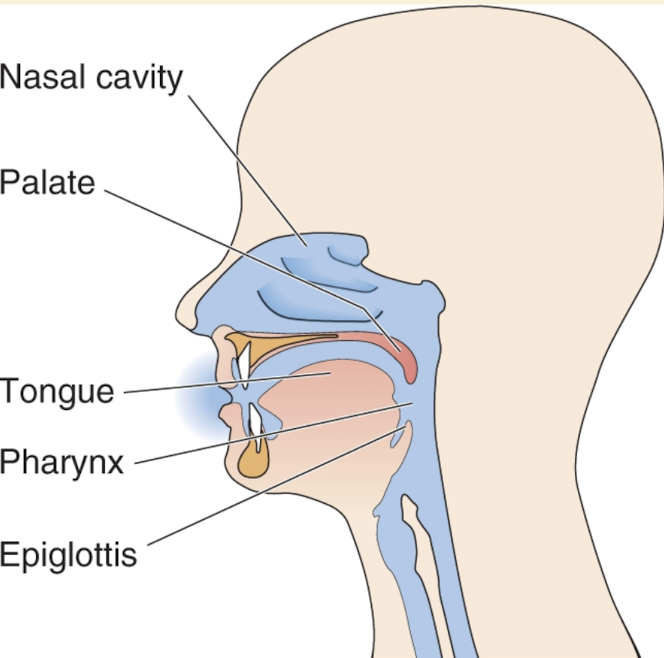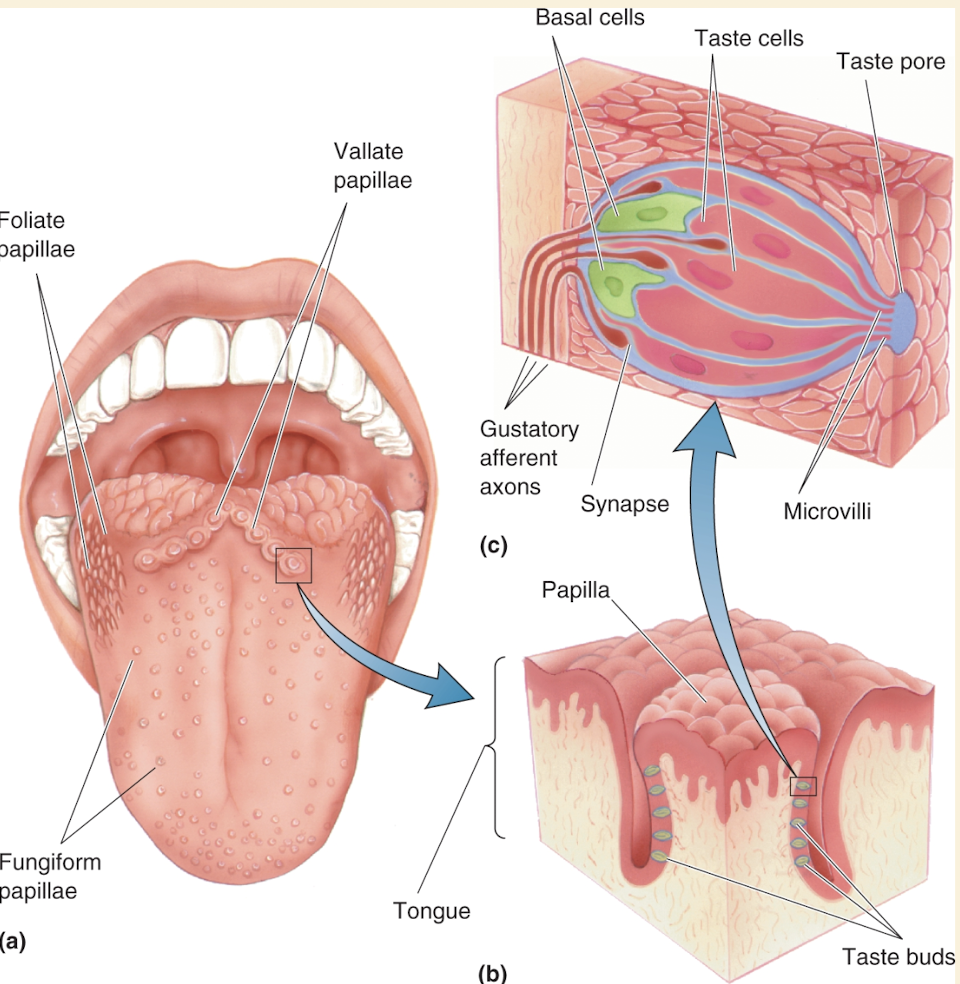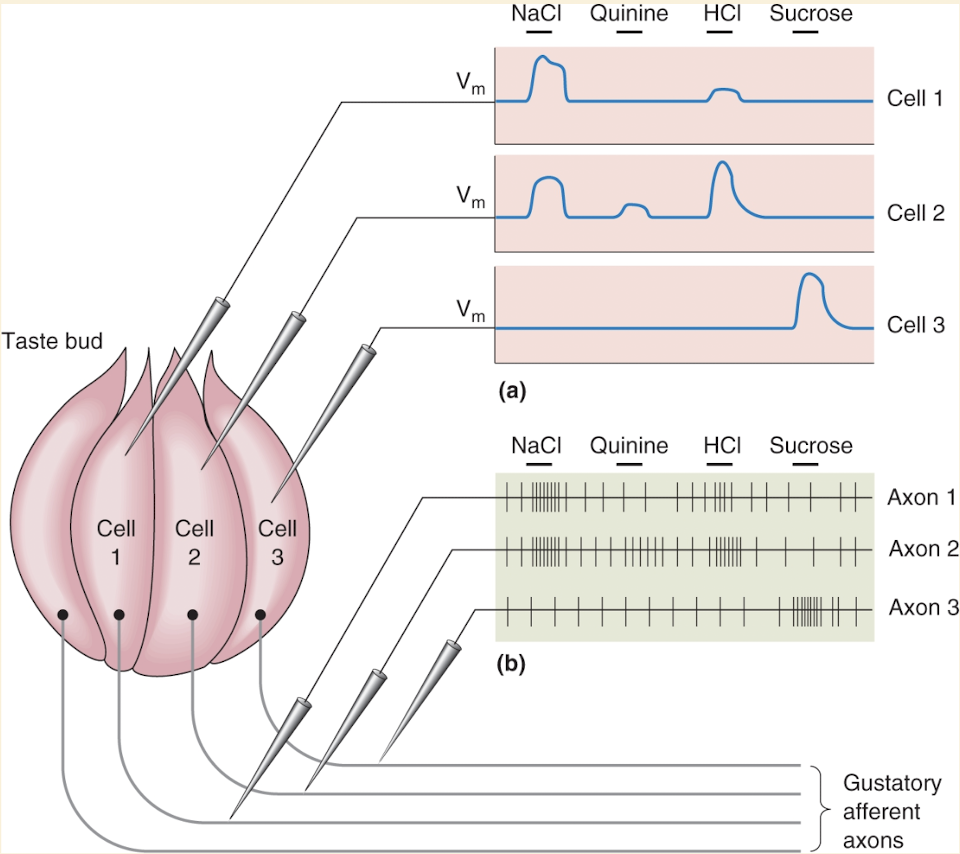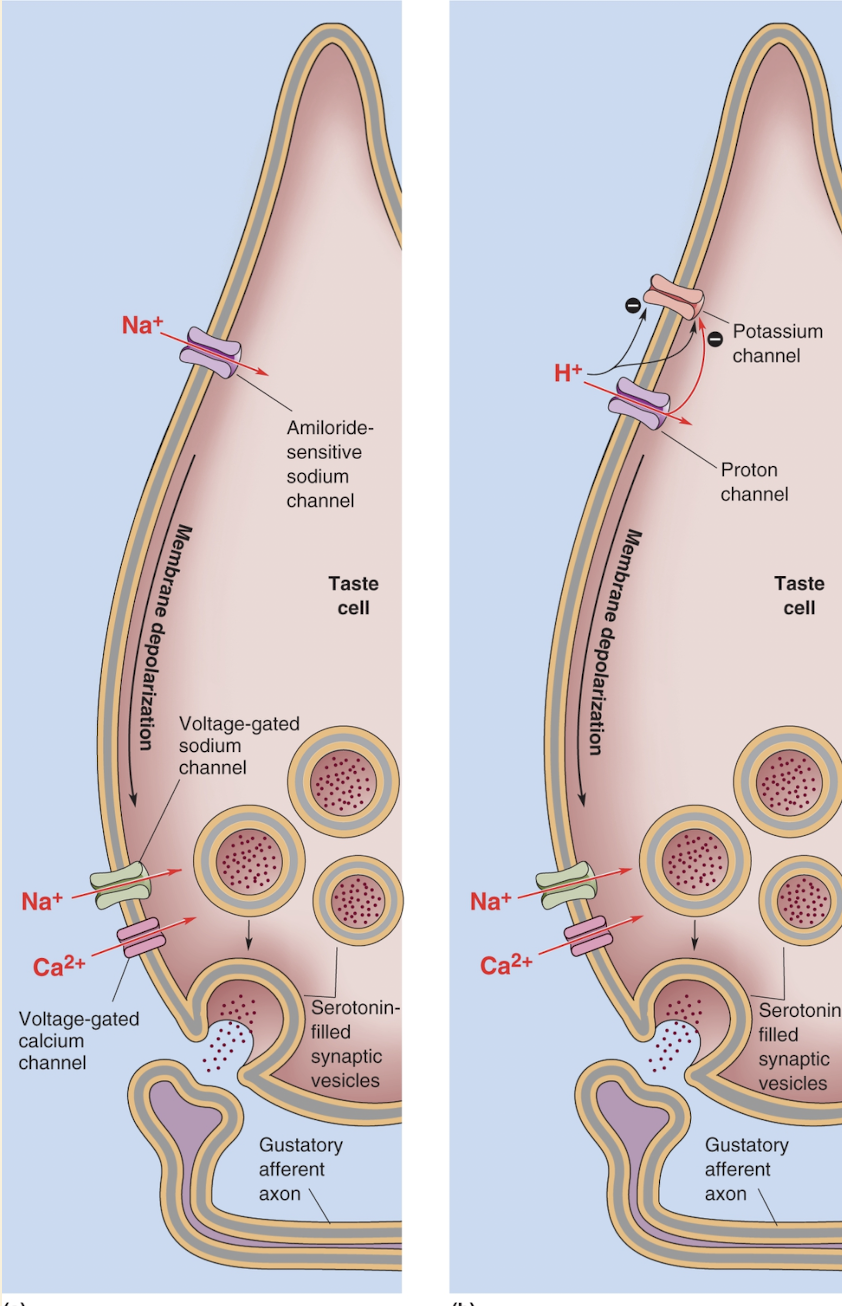Chemical Senses I - Guistation
The Basic Tastes
There are 5 basic tastes:
Saltiness
Sourness
Sweetness
Bitterness
Umami
Savory taste of glutamate, monosodium glutamate
Are there taste receptors beyond the basic 5?
Yes, likely
Some recent research thinks we can taste & have specific receptors for:
Fat
Carbonation (likely from sour taste cells)
Calcium
Water
Chemistry of substances can vary while taste is the same
Sugars are less sweet than artificial sweeteners (1:10,000)
Bitter substances can be simple ions or complex molecules
How do we taste so much with only 5 basic types of taste?
Each food activates diff combination of basic taste - uniqueness
Distinct flavor due to combined taste and smell
e.g. w/o combined taste & smell onion can be mistaken for apple
Texture and temperature also play important role
Pain sensations - spicy food
The organs of Taste

Tongue
Tip is most sensitive to sweetness
Back is most sensitive to bitterness
Sides are most sensitive to saltiness and sourness
Papillae: small bumps on tongue shaped like ridges
Each one has one to hundreds of tastebuds (only visible with a microscope)
Each tastebud has 50-150 taste receptor cells
Each papilla has multiple types of taste receptors specialized for different categories of taste
Palate
Pharynx
Odors from food pass by here into nasal cavity > detected by olfactory receptors
Epiglottis
Threshold concentration: the minimum level of a substance required for it to be perceived by taste receptors - too low concentration = no taste
At concentrations just above threshold papillae tend to be sensitive to only one basic taste
At increased concentrations, papillae will become less selective
Question: what happens when sick because you cannot taste, is it because sense of smell is gone or because of receptors not sensing taste?

Taste Receptor Cells
Apical end: chem sensitive part of a taste receptor cell, small membrane region
Microvilli: thin extensions that project into the taste pore
Taste pore: small opening on the surface of the tongue where the taste cell is exposed to contents of the mouth
Taste receptor cells are not neurons but do form synapses with endings of gustatory afferent axons near bottom of taste bud
Also make electrical & chem synapses onto some of the basal cells
Some basal cells synapse onto sensory axons & form simple information-processing circuit within each taste buds
Lifespan of one taste cell is about 2 weeks
Nerve cut = degeneration
Chem activates receptor cell → membrane depolarizes (voltage shift = receptor potential) → action potential
In any case of depolarization Ca2+ channels will open → Ca2+ enter cytoplasm → NTMs release → post synapse fires AP which communicate taste signal into brain
Basic transmission from taste cell → sensory axon
Sour & salty → serotonin onto gustatory axons
Sweet, bitter, & umami release ATP as NTM

Evidence from recent studies suggests most taste receptor cells respond primarily to one of 5 basic tastes
e.g. cells 1 & 3 in figure above
Each gustatory axon in the figure is influenced by several tastes but each has bias
Mechanisms of Taste Transduction
Transduction: process by which an environmental stimulus causes an electrical response in a sensory receptor cell
Nature of transduction mechanism determines specific sensitivity of a sensory system
e.g. because eyes have photoreceptors we can see, if mouth had photoreceptors then we might see with our mouth
Some sensory systems have single basic type of receptor cell that uses one transduction mechanism (e.g. auditory system)
Taste uses several diff processes & each basic taste uses one or more of mechanisms
Taste stimuli (tastants) may
Salt and Sour: Directly pass through ion channels
Sour: Bind to & block ion channels
Bitter, Sweet, Umami: Bind to G-protien coupled receptors in the membrane → activate second system messenger systems → opening of ion channels
Saltiness
In relatively low concentrations (10-150 mM) tastes good, but higher concentrations are not good tasting
To detect low concentrations taste cells use Na+ selective channel
Common in other epithelial cells
Blocked by drug amiloride
Insensitive to voltage & generally stays open (unlike sodium gated ion channel)
Taste chicken soup → Na+ rises outside the receptor cell → gradient for Na+ across the membrane is made steeper → Na+ diffuses down concentration gradient → inward current causes membrane to depolarize (receptor potential) → voltage gate sodium & calcium channels open near the synaptic vesicles → release of NTM onto gustatory afferent axon

Sourness
Foods taste sour bc of high acidity
Acids, such as HCl, dissolve in water & generate hydrogen ions → protons causative agents of acidity & sourness
Protons can affect the taste receptors in diff ways from either inside or out
Likely H+ can bind & block special K+ selective channels
When K+ permeability is decreased membrane depolarizes
H+ may also activate or permeate special type of ion channel from superfamily of transient receptor potential (TRP) channels
Cation current through TRP channels can depolarize sour receptor cells
Bitterness
Transduction process relies on two families of taste receptor proteins, T1R & T2R
Subtypes of T1R & T2R are G-protein coupled receptors that are similar to the ones that detect NTMs
Evidence protein receptors for bitter, sweet & umami are dimers
Dimers: two proteins affixed to one another
Bitter substances are detected by the 25 types of T2 receptors in humans
Bitter receptors are poison detectors & because we have so many can detect various poisons
Since each taste cell can send only one type of signal to afferent nervous, a chem that can bind to one of 25 bitter receptors will trigger the same response as a diff chem that binds to another of its bitter receptors
The only important message brain receives is that a bitter chem is bad and shouldn’t be truster
Nervous system does not distinguish between one type of bitter substance from another
Receptors use second messenger pathway to carry signal to gustatory afferent axon
Sweet & umami use the same second messenger pathway
The pathway
Tastant binds to a bitter (or sweet/umami) receptor activating the G-protien
Enzyme phospolipase C is stimulated increase production of intracellular messenger IP3
IP3 activates special type of ion channel unique to taste cells causing it to open
Na+ enters and depolarizes the taste cell
IP3 also triggers release of Ca2+
Ca+ triggers release of NTMs in unusual way
Lacks transmitter-filled presynaptic vesicles
Special membrane channel allows ATP to flow out of the cell where ATP acts as transmitter
ATP activates purinergic receptors on postsynaptic gustatory axons

Sweetness
Many diff sweet tastants, some natural, some artificial
All detected from the same taste receptor
Sweet receptors resemble bitter receptors bc also dimers
Requires two members of T1R receptor family: T1R2 & T1R3
If either are missing or mutate animal may not perceive sweetness
Chems binding to T1R2 + T1R3 receptor activate same 2nd messenger system that bitter receptors activate
Why don’t we confuse bitter with sweet?
Reason is bitter receptor proteins & sweet receptor proteins are expressed in diff taste cells & in turn connect to different gustatory axons
Activity of diff gustatory axons reflects chem sensitivities of taste cells that drive them so messages about sweet & bitter are delivered to CNS along diff transmission lines
Umami
Transduction process is identical to sweetness w/one exception - umami receptor is composed of T1R1 & T1R3
Sweet & umami share T1R3 but T1R1 determines the umami taste
When T1R1 is removed from mice they cannot taste glutamate & other amino acids but can still sense sweet things
Bats do not have functioning T1R1 receptor & cannot taste amino acids (cannot taste sweet & umami)
Has the same messenger pathway as sweet & bitter
What don’t we confuse taste of amino acids w/sweet or bitter?
Taste cells selectively express only one class of taste receptor protein
Umami specific taste cells stimulate gustatory axons that deliver messages of umami
Central Taste Pathways
Main flow of taste info
Taste buds → gustatory axons → brain stem → thalamus → cerebral cortex
Three cranial nerves carry primary gustatory axons & bring taste info to the brain
Anterior two thirds of the tongue & palate → facial nerve
Posterior third of tongue → glossopharyngeal nerve
Regions around throat (glottis, epiglottis, pharynx) → vagus nerve
Cranial nerve taste axons enter brain stem, bundle together, and synapse within gustatory nucleus as part of solitary nucleus in medulla
From gustatory nucleus, taste pathways diverge
Neurons of the gustatory nucleus synapse on subset of small neurons in the VPM nucleus (deals w/sensory info from head) → VPM sends axons to the primary gustatory cortex
Taste pathways to thalamus & cortex are primarily ipsilateral to cranial nerves that supply them
Experience of taste is presumably mediated by cerebral cortex
Gustation is important to basic behaviors of feeing & digestion
Involved with swallowing, salvation, gagging, vomiting, digestion, & respiration
The Neural Coding of Taste
Basic idea of a coding system for taste
One way to imagine taste coding: each unique taste (sweet, salty, chocolate, mango, beef, etc.) could have its own special receptor in the tongue.
Each receptor would connect to its own set of axons → neurons in the brain → up to the cortex.
In this “labeled line” idea, chocolate activates only “chocolate” neurons, sweet activates only “sweet” neurons, etc.
Example: chocolate ice cream would fire “chocolate” and “sweet” cells strongly, but not “salty” or “banana” cells.
Labeled Line Hypothesis
This is the idea that each taste has a dedicated line from the tongue to the brain.
It’s simple and rational, but not exactly how the brain really works.
How taste receptor cells actually behave
Some taste receptor cells are specific: they mostly respond to one category (sweet, bitter, or umami).
Others are broadly tuned: they respond to more than one category (e.g., salt and sour).
This makes the information coming from a single taste receptor ambiguous (uncertain).
Primary taste axons (the “wires” to the brain)
Even less specific than receptor cells.
They often collect signals from multiple receptor cells at once.
Example: one axon might get input from a “sour-preferring” cell and a “salt-preferring” cell → making the axon respond to both.
Why cells are broadly tuned
A single receptor cell can have two different detection mechanisms, so it responds to more than one taste.
Multiple receptor cells can send signals into the same axon → combining their information.
In the brain, this continues: neurons in the gustatory nucleus receive input from many axons → becoming even less selective.
Problem with labeled lines
If we used only highly specific cells, we’d need thousands of receptor types (chocolate, strawberry, mango, beef, etc.).
That would still fail for new or unusual tastes we haven’t evolved receptors for.
Population Coding (the actual strategy used)
The brain interprets taste by looking at the pattern of activity across many neurons.
Each food excites a unique combination of neurons:
Some neurons fire strongly, some weakly, some not at all, some may even be inhibited.
The overall pattern tells the brain “this is chocolate ice cream” vs. “this is chocolate cake.”
This method allows for huge variety and flexibility in taste recognition.
Other sensory contributions
Taste perception isn’t just about taste receptor cells.
Smell (olfaction), temperature, and texture also contribute.
Example: chocolate ice cream vs. chocolate cake → both taste like chocolate, but coldness and creaminess vs. warmth and fluffiness help the brain tell them apart.
Big picture
Taste coding is not just one-to-one “wires” for each flavor.
It’s a population code: the brain compares patterns across many neurons to identify and distinguish foods.
This scheme is similar to how the brain processes other senses (like smell, vision, and movement).